标签:
我们开发网站项目的时候,都会遇到这样的问题:就是页面怎么统一风格,有一致的外观,在之前ASP.NET的时代,我们有两种选择,一个是使用MasterPage页,一个是手动,自己在每个页面写CSS样式,但这样代码量太大了。。不可取,那么到了ASP.NET MVC时代,有什么技术可以统一页面风格呢???有,那就是Layout布局视图。下面就开始学习吧。
1. 首先使用空模板,新建一个MVC Web项目:
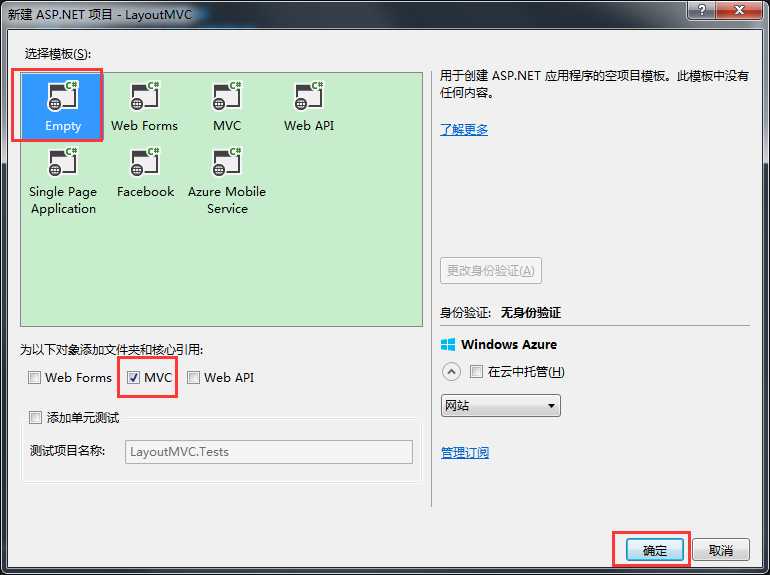
新建完成之后,初始化状态是:
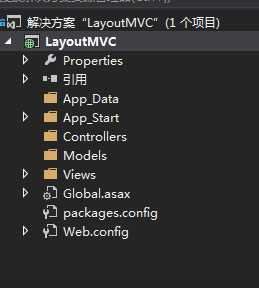
2.接着在根目录【LayoutMVC这里是】下,新建一个文件夹【Content】,在里面添加一个css文件,取名【Site.css】
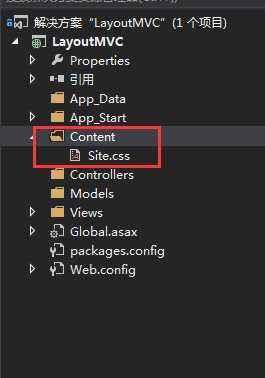
3.在【Views】文件夹下,新建一个【Shared】文件夹,在Shared文件夹下,新建一个Layout布局页
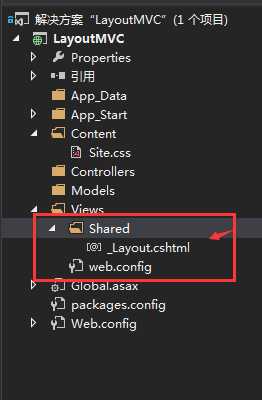
布局页:
<!DOCTYPE html>
<html>
<head>
<meta name="viewport" content="width=device-width" />
<title>@ViewBag.Title</title>
@*Url.Content将虚拟路径转化为应用程序的绝对路径 *@
<link href="@Url.Content("~/Content/Site.css")" rel="stylesheet" />
</head>
<body>
<header>
<div class="content-wrapper">
<div class="float-left">
<p class="site-title">
@Html.ActionLink("Code Express", "Index", "Home")
</p>
</div>
<div class="float-right">
<nav>
<ul id="menu">
<li>@Html.ActionLink("Home", "Index", "Home")</li>
<li>@Html.ActionLink("About", "About", "Home")</li>
</ul>
</nav>
</div>
</div>
</header>
<div id="body">
@RenderSection("featured", required: false)
<section class="content-wrapper main-content clear-fix">
@RenderBody()
</section>
</div>
<footer>
<div class="content-wrapper">
<div class="float-left">
<p>© @DateTime.Now.Year – Code Express</p>
</div>
</div>
</footer>
</body>
</html>In this layout we are using a HTML helper method and some other system defined methods so let‘s see these methods one by one. 在布局页里面,我们使用了HTML帮助类的方法,和其他一些系统定义的方法,我们来分别看看这些方法。
Url.Content(): Content() method is a method of UrlHelper class. It converts a virtual (relative) path to an application absolute path.
It has one parameter of string type that is a virtual path of the content.
It returns an application‘s absolute path.
If the specified content path (parameter of the method) does not start with the tilde (~) character then this method returns contentPath unchanged.
Url.Content() ensures that all links work no matter if the site is in a virtual directory or in the web site root.
URL。Content方法,是UrlHelper类中的方法,它可以把虚拟【相对】路径转化为应用程序的绝对路径,它有一个string类型的参数,也就是文件的虚拟路径。如果这个路径没有以~波浪线开头,然后这个方法就会返回一个固定路径,
它确保所有的链接都能正常工作,不管站点是在虚拟路径中或者是在网站的根目录下。
Html.ActionLink(): The easiest way to render an HTML link in is to use the HTML.ActionLink() helper.
With MVC, the Html.ActionLink() does not link to a view.
It creates a link to a controller action. ActionLink() is an extension method of the HtmlHelper class.
It returns an anchor element (an element) that contains the virtual path of the specified action.
When you use an ActionLink() method then you need to pass three string parameter.
The parameters are linkText (the inner text of the anchor element), actionName (the name of the action) and controllerName (the name of the controller).
HTML.ActionLink方法,这是最简单的方法,来做一个HTML链接。在MVC中HTML.ActionLink不是链接到视图,而是链接到控制器的方法,ActionLink是HTMLHelper类的扩展方法。
它返回了一个包含指定Action的虚拟路径的链接。使用ActionLink需要传递3个参数,第一个是链接显示的文本,第二个是要链接的控制器方法,第三个是控制器的名字。
RenderSection(): RenderSection() is a method of the WebPageBase class.
Scott wrote at one point, The first parameter to the "RenderSection()" helper method specifies the name of the section we want to render at that location in the layout template.
The second parameter is optional, and allows us to define whether the section we are rendering is required or not.
If a section is "required", then Razor will throw an error at runtime
if that section is not implemented within a view template that is based on the layout file (that can make it easier to track down content errors). It returns the HTML content to render.
RenderSection是WebPageBase类中的方法,我们可以在布局页中使用它来,作为一个占位符,就和ASP.NET中类似,有两个参数,一个是名字,一个是Required,Required设置为True的时候,我们在视图中就一定要添加这个块,否则运行的时候,报错。
RenderBody(): In layout pages, renders the portion of a content page that is not within a named section. It returns the HTML content to render. RenderBody is required, since it‘s what renders each view.
RenderBody是加载显示,不在RendSection代码快中的内容,RenderBody是必须要的。
The _ViewStart File
_ViewStart文件,指定了使用的布局页,如果没有的话,你就需要在每个视图中手动,添加
@{
Layout = "~/Views/Shared/_Layout.cshtml";
}
The "_ViewStart" file in the Views folder contains the following content: @{ Layout = "~/Views/Shared/_Layout.cshtml"; }
This code is automatically added to all views displayed by the application. If you remove this file then you must add this line to all views.
4.接着,我们新建一个控制器Home,创建对应的Index视图,指定我们刚才创建的布局页
public class HomeController : Controller
{
// GET: Home
public ActionResult Index()
{
return View();
}
}
@{
ViewBag.Title = "Index";
Layout = "~/Views/Shared/_Layout.cshtml";
}
<h2>Index</h2>
5.运行程序:
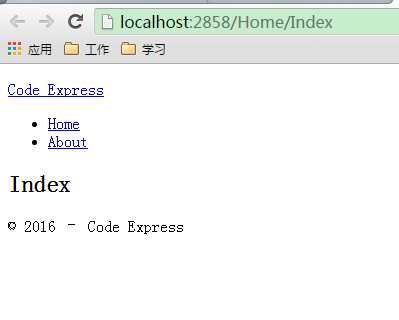
MVC学习系列5--Layout布局页和RenderSection的使用
标签:
原文地址:http://www.cnblogs.com/caofangsheng/p/5675724.html